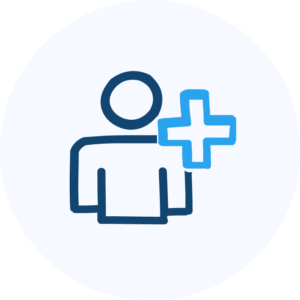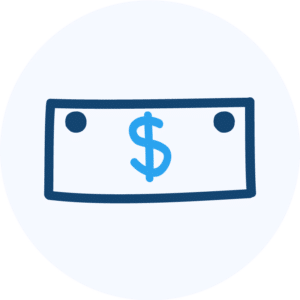According to a recent Prophecy Market Insights research report, the remote patient monitoring (RPM) market stood at $53.6 billion in 2022, and it’s expected to grow to an impressive $627.1 billion by 2032. This market growth was in part propelled by the increased focus on telehealth in recent years and the ensuing establishment of virtual care teams within health systems to support remote care management models. However, RPM is not just a temporary solution; its trajectory indicates a sustained growth due to technological advancements and its increasingly diverse applications.
But what is remote patient monitoring, and what makes it such a promising telehealth model? Dive in as we explore its inner workings, benefits, and the roadmap to its rising popularity.
The RPM market stood at
$53.6 billion
in 2022
The RPM market is expected to grow to
$627.1 billion
by 2032
What is Remote Patient Monitoring?
Remote patient monitoring is a model of care delivery that involves leveraging a system of tools and technologies to track and record a patient’s condition from another location. For example, a patient can be set up with RPM at home, allowing doctors and other practitioners to closely track vital signs and other essential physiological data while the patient is in the comfort of their home.
This can be a great middle ground for patients and providers: The patient can avoid lengthy and expensive hospital stays by remaining at home, while care providers can still collect and analyze the patient’s health data from afar while being able to work asynchronously. RPM care also can include regular interactive check-ins, usually carried out remotely via phone or video chat.
In short, remote patient monitoring enables patients to receive attentive care from the comfort of their homes and empowers providers to deliver high-quality care to patients remotely and on a regular basis.
What is RPM Used For?
Remote patient monitoring can be used to treat both chronic and more urgent acute conditions, making it a vital tool for preventative care.
For example, it can help monitor chronic conditions, such as congestive heart failure, chronic obstructive pulmonary disease (COPD), kidney disease, diabetes, cancer, stroke, multiple sclerosis, and more. It can also help track vital signs and other physiological data of high-risk patients after they’ve been discharged from acute care.
RPM can support a diverse range of treatments, and as such, it’s become integral to many types of care management, including:
- Managing population health, including chronic care management
- Overseeing post-discharge management, including both principal and transitional care management
- Facilitating hospital-at-home models
How It Works
With this RPM definition in mind, what does it look like in practice?
Remote patient monitoring programs integrate various devices like blood pressure monitors, scales, pulse oximeters, spirometers, and more. These devices are usually pre-configured and designed to be easily set up and used by patients in their homes, and the data they collect often gets transmitted to healthcare providers in near real time so they can track and monitor the data continuously — even while patients are asleep.

This symbiotic tech relationship between data collection and communication paints the full picture of RPM, culminating in a holistic clinical portal and EHR integration.
Why Is RPM on the Rise?
RPM provides wins for patients, providers, and payers.

For patients
RPM offers a more flexible way of receiving treatment, often from the convenience of their own home. They can also keep tabs on their care details, promoting deeper engagement with their health, and they may feel comfortable knowing they can always stay in contact with their caregivers. That’s not to mention the potential cost savings — less money and time spent on travel and fewer trips to the clinic or hospital.
For providers
RPM can enhance the patient experience while allowing providers to increase their focus on serious medical conditions. Many patients often feel more comfortable receiving care at home, and 24/7 monitoring services can provide more detailed data and insight into their condition. The ability to communicate more regularly can even shed light on certain challenges they’re facing. All these factors can contribute to better overall patient health outcomes — the ultimate goal of any model of care.

For payers
RPM can help provide more effective, value-based care for chronic conditions that are usually evasive and difficult to treat without superior data collection and analysis. In doing so, remote patient monitoring can help reduce claims for readmissions, escalations, and other events, as doctors are in regular contact with patients and tracking their conditions at all times. This can directly translate to cost savings.
These factors and more are major contributors to RPM market growth and popularity, and as the technology evolves and costs come down even further, RPM will continue to grow exponentially.
How Is Remote Therapeutic Monitoring Different?
Remote patient monitoring often gets confused with remote therapeutic monitoring (RTM), but how are they different? Generally, the major distinction between the RPM definition and RTM definition comes down to the data collected:
RPM collects physiological data
RTM collects non-physiological data
RTM is most often used by therapists to track or supervise a patient’s behavior and provide data-driven therapy in the form of educational content or coaching sessions. For example, RTM may be used to ensure a patient adheres to their medication or physical therapy regimen or to gain insight into cognitive conditions, like attention-deficit disorder, hyperactivity, or substance abuse.
Right now, CMS-reimbursed conditions are limited to the musculoskeletal and respiratory systems. However, the list of covered therapies will likely expand in the years to come.
Knowing the differences between RTM and RPM is vital to appropriately coding and delivering the right care to the right patients.
The Role RPM Plays as the Healthcare Industry Evolves
As many healthcare providers and organizations prepare to shift to a value-based care model, remote patient monitoring presents a critical foundation for its delivery. It empowers care providers to gain more insight into patient conditions and achieve higher-quality health outcomes without requiring repeat visits to the hospital or unnecessary testing.
The ease of access, robust data capabilities, and economic viability of RPM devices make them indispensable in today’s care management landscape. As a result, RPM isn’t just a passing trend; it’s charting the path for the future of care management.
Looking for more information about RPM or wondering how you can get started with it? Connect with a CareSimple RPM specialist today.
